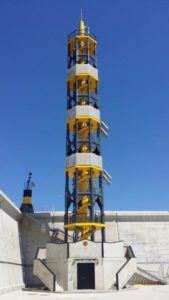
The lighthouse of the Port of València located in the northern extension, with an initial estimated life of 50 years, will far exceed this figure
Tests carried out after the first two years of operation show that some properties of the lighthouse, such as traction, have improved
The results show that the material shows no degradation of the fibre (glass and carbon) after 2 years of ageing
It was the first lighthouse in the world built entirely with lightweight materials that guarantee greater resistance to marine environments and incorporates ten solar panels facing south
València, November 11th, 2021.- The Port of València Lighthouse has become an example of sustainability worldwide, an infrastructure created with composite materials such as carbon fibre and fibreglass. An example of sustainable and innovative infrastructure, but also of durability and efficiency, which will serve as a model to determine the duration of constructions made with these materials. This was explained this morning by Raúl Cascajo, head of Environmental Policies at the PAV and Ignacio Pascual, the architect who designed the lighthouse and former head of Infrastructures at the PAV, at the conference: Plastics in construction, new solutions, success stories and challenges in the sector organised by the Technological Institute of Plastics (AIMPLAS).

The Lighthouse is in the northern extension of the Port of Valencia and was commissioned in summer 2015. To test the durability and efficiency of this infrastructure, removable test pieces were introduced to carry out laboratory tests to show its capacity to resist ageing. The results of the first analysis show that the material shows no degradation of the fibre (glass and carbon) after 2 years of ageing exposed to solar radiation, water or winds. Even some properties, such as traction, have improved after two years.
“After checking these tests and seeing the positive results, we have decided to carry out the next sample after seven years instead of the planned five years. The next extraction will take place in 2023, after seven years of ageing to carry out the same tests, verify if there is any modification of properties and confirm the durability of the selected material,” explained Ignacio Pascual.
In principle, according to building regulations, concrete structures have a useful life that cannot be less than 50 years. In the case of constructions with composite materials, there are no regulations, and the case of the Lighthouse of the Port of València serves to determine the durability of these infrastructures, which according to the first tests will exceed 50 years by far.
“The lighthouse is one more example of the projects being carried out by the PAV in its decarbonisation strategy, which is based on pillars such as the Port of Valencia’s electrical substation, the use of alternative fuels (LNG or hydrogen), the use of renewable energies (photovoltaic, wind, wave) or the electrical connection to moored ships”, emphasised Raúl Cascajo.
A world reference in sustainability
The Port of Valencia lighthouse installed in the northern extension was the first in the world to be built entirely with composite materials such as carbon fibre and fibreglass, which makes it very light, weighing only 3,000 kilos. In this sense, the use of composite materials guarantees greater resistance to exposure to marine environments as they are not affected by corrosion, less maintenance work and a 20% reduction in CO2 emissions in the construction process by requiring less displacement of heavy materials.
The installation uses LED technology, which allows a range of 25 nautical miles, with an electrical consumption of 70 watts and a useful life of 100,000 hours. It is also self-sufficient as it uses renewable energies. Specifically, the lighthouse incorporates ten south-facing solar panels and a vertical axis wind turbine, which contributes to significantly reducing its energy consumption. In 2016, the lighthouse received the JEC World Innovation Awards, one of the world’s most important awards in the field of composite materials.

